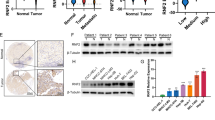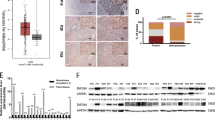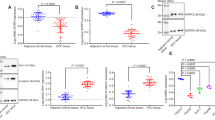Abstract
Hepatocellular carcinoma is a well-known malignancy in the world. However, the molecular mechanism of carcinogenesis and tumour progression remains unclear. Recently, reduced E-cadherin expression due to transcriptional suppressor Snail was proven in a panel of epithelial and dedifferentiated cells derived from carcinomas of various etiologies. In the present study, we examined Snail and E-cadherin mRNA/protein expression in five hepatocellular carcinoma cell lines with variable phenotypes (HuL-1, Hep-G2, Changliver, HLE, and HLF). The results demonstrated that the presence of Snail mRNA in HuL-1, Changliver, HLE and HLF cells detected by RT–PCR, which was further proven by in situ hybridization in tumours induced by HuL-1, Changliver, and HLF cells where Snail mRNA signals expressed in each of the sections. By contrast, E-cadherin mRNA and protein expression were only detected in Hep-G2 cells by RT–PCR and Western blot, respectively. These results were also consistent with the data obtained from in vivo immunohistochemical staining where membranous expression of endogenous E-cadherin protein was revealed only in tumour sections induced by Hep-G2 cells. Here we are the first to report that there is an inverse correlation between Snail and E-cadherin expression in HCC cells as well.
This is a preview of subscription content, access via your institution
Access options
Subscribe to this journal
Receive 24 print issues and online access
$259.00 per year
only $10.79 per issue
Buy this article
- Purchase on Springer Link
- Instant access to full article PDF
Prices may be subject to local taxes which are calculated during checkout



Similar content being viewed by others
References
Ariizumi SI, Takasaki K, Yamamoto M, Otsubo T, Katagiri S, Saito A (2001) Eight multicentric hepatocellular carcinomas occurring in the same segment of the liver. J Hepatobiliary Pancreat Surg 8: 383–386
Batlle E, Sancho E, Franci C, Dominguez D, Monfar M, Baulida J, Garcie De Herreros A (2000) The transcription factor snail is a repressor of E-cadherin gene expression in epithelial tumour cells. Nat Cell Biol 2: 84–89
Bergsland EK, Venook AP (2000) Hepatocellular carcinoma. Curr Opin Oncol 12: 357–361
Bracke ME, Van Roy FM, Mareel MM (1996) The E-cadherin/catenin complex in invasion and metastasis. Curr Top Microbiol Immunol 213: 123–161
Buendia M (2000) Genetics of hepatocellular carcinoma. Semin Cancer Biol 10: 185–200
Cano A, Perez-Moreno MA, Rodrigo I, Locascio A, Blanco MJ, del Barrio MG, Portillo F, Nieto MA (2000) The transcription factor snail controls epithelial-mesenchymal transitions by repressing E-cadherin expression. Nat Cell Biol 2: 76–83
Chang RS (1978) HeLa marker chromosomes, Chang liver cells, and liver-specific functions. Science 199: 567–568
Cook PR (1999) The organization of replication and transcription. Science 284: 1790–1795
Dor I, Namba M, Sato J (1975) Establishment and some biological characteristics of human hepatoma cell lines. Gann 66: 385–392
Durr R, Caselmann WH (2000) Carcinogenesis of primary liver malignancies. Langenbecks Arch Surg 385: 154–161
Endo K, Ueda T, Ueyama J, Ohta T, Terada T (2000) Immunoreactive E-cadherin, alpha-catenin, beta-catenin, and gamma-catenin proteins in hepatocellular carcinoma: relationships with tumor grade, clinicopathologic parameters, and patients' survival. Hum Pathol 31: 558–565
Feitelson MA (1998) Hepatitis B x antigen and p53 in the development of hepatocellular carcinoma. J Hepatobiliary Pancreat Surg 5: 367–374
Giroldi LA, Bringuier PP, de Weijert M, Jansen C, van Bokhoven A, Schalken JA (1997) Role of E boxes in the repression of E-cadherin expression. Biochem Biophys Res Commun 241: 453–458
Guyton KZ, Kensler TW (1997) Prevention of liver cancer. Curr Opin Oncol 9: 492–496
Hayashi Y, Wang W, Ninomiya T, Nagano H, Ohta K, Itoh H (1999) Liver enriched transcription factors and differentiation of hepatocellular carcinoma. Mol Pathol 52: 19–24
Hedin KE, Kaczynski JA, Gibson MR, Urrutia R (2000) Transcription factors in cell biology, surgery, and transplantation. Surgery 128: 1–5
Hemavathy K, Ashraf SI, Ip YT (2000) Snail/slug family of repressors: slowly going into the fast lane of development and cancer. Gene 257: 1–12
Hennig G, Lowrick O, Birchmeier W, Behrens J (1996) Mechanisms identified in the transcriptional control of epithelial gene expression. J Biol Chem 271: 595–602
Huang GT, Lee HS, Chen CH, Sheu JC, Chiou LL, Chen DS (1999) Correlation of E-cadherin expression and recurrence of hepatocellular carcinoma. Hepatogastroenterology 46: 1923–1927
Huh N, Utakoji T (1981) Production of HBs-antigen by two new human hepatoma cell lines and its enhancement by dexamethasone. Gann 72: 178–179
Hussain SP, Harris CC (2000) Molecular epidemiology and carcinogenesis: endogenous and exogenous carcinogens. Mutat Res 462: 311–322
Jiao W, Miyazaki K, Kitajima Y (2001) Exogenous expression of E-cadherin in gallbladder carcinoma cell line G-415 restores its cellular polarity and differentiation. Int J Oncol 19: 1099–1107.
Kanai Y, Ushijima S, Hui AM, Ochiai A, Tsuda H, Sakamoto M, Hirohashi S (1997) The E-cadherin gene is silenced by CpG methylation in human hepatocellular carcinomas. Int J Cancer 71: 355–359
Knowles BB, Howe CC, Aden DP (1980) Human hepatocellular carcinoma cell lines secrete the major plasma proteins and hepatitis B surface antigen. Science 209: 497–499
Kojiro M (2000) Premalignant lesions of hepatocellular carcinoma: pathologic viewpoint. J Hepatobiliary Pancreat Surg 5: 367–374
Kondoh N, Wakatsuki T, Hada A, Shuda M, Tanaka K, Arai M, Yamamoto M (2001) Genetic and epigenetic events in human hepatocarcinogenesis. Int J Oncol 18: 1271–1278
Li LC, Chui RM, Sasaki M, Nakajima K, Perinchery G, Au HC, Nojima D, Carroll P, Dahiya P (2000) A single nucleotide polymorphism in the E-cadherin gene promoter alters transcriptional activities. Cancer Res 60: 873–876
Oda T (1999) Viral hepatitis and hepatocellular carcinoma prevention strategy in Japan. Jpn J Cancer Res 90: 1051–1060
Okuda K (2000) Hepatocellular carcinoma. J Hepatol 32: 225–237
Osada T, Sakamoto M, Ino Y, Iwamatsu A, Matsuno Y, Muto T, Hirohashi S (1996) E-cadherin is involved in the intrahepatic metastasis of hepatocellular carcinoma. Hepatology 24: 1460–1467
Takeichi M (1991) Cadherin cell adhesion receptors as a morphogenetic regulator. Science 251: 1451–1455
Takeichi M (1993) Cadherins in cancer: implications for invasion and metastasis. Curr Opin Cell Biol 5: 806–811
Yokoyama K, Kamata N, Hayashi E, Hoteiya T, Ueda N, Fujimoto R, Nagayama M (2001) Reverse correlation of E-cadherin and snail expression in oral squamous cell carcinoma cells in vitro. Oral Oncol 37: 65–71
Yu MC, Yuan JM, Govindarajan S, Ross RK (2000) Epidemiology of hepatocellular carcinoma. Can J Gastroenterol 14: 703–709
Acknowledgements
We acknowledge Dr Yongxin Chen for histopathological judgement and photography, and Miss Yuko Ichimaru for helping histologic sections.
Author information
Authors and Affiliations
Corresponding author
Rights and permissions
About this article
Cite this article
Jiao, W., Miyazaki, K. & Kitajima, Y. Inverse correlation between E-cadherin and Snail expression in hepatocellular carcinoma cell lines in vitro and in vivo. Br J Cancer 86, 98–101 (2002). https://doi.org/10.1038/sj.bjc.6600017
Received:
Revised:
Accepted:
Published:
Issue Date:
DOI: https://doi.org/10.1038/sj.bjc.6600017
Keywords
This article is cited by
-
Emodin inhibits invasion and migration of hepatocellular carcinoma cells via regulating autophagy-mediated degradation of snail and β-catenin
BMC Cancer (2022)
-
Structures and biological functions of zinc finger proteins and their roles in hepatocellular carcinoma
Biomarker Research (2022)
-
Oleanolic acid attenuates TGF-β1-induced epithelial-mesenchymal transition in NRK-52E cells
BMC Complementary and Alternative Medicine (2018)
-
Snail collaborates with EGR-1 and SP-1 to directly activate transcription of MMP 9 and ZEB1
Scientific Reports (2017)
-
FAM83H is involved in the progression of hepatocellular carcinoma and is regulated by MYC
Scientific Reports (2017)



